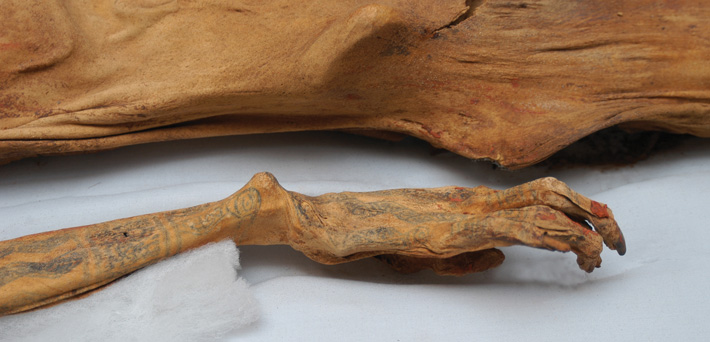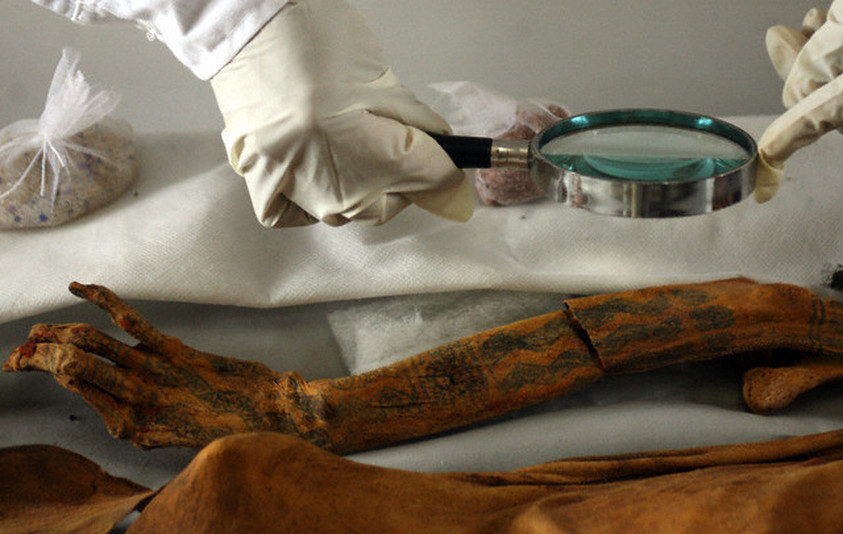Tomb of the Tattooed Sorceress Queen, The Lady of Cao
The day had been spent in ritual battles, and a group of individuals who were vanquished, naked, and tied-together were marched up the long stairs to the top platform of the great pyramid where there they were killed, throats cut, sacrificed to their supreme deity. A great silver goblet, the mark of a ruler in Moche society, was used to collect the blood and then the blood was consumed by the priestess-queen and the circle was completed, for life feeds on life, and this seems to have been a fundamental cultural concept for the violent, passionate Moche society.

This ritual is depicted on the walls of the Moche temples and while not a great deal is known about this enigmatic pre-Incan culture, what we do know from their wall paintings and reliefs as well as their exquisitely executed pottery is that these people lived life as voraciously as they embraced death. They celebrated nature, engaged in sexual acts, violence, birth, and death with great aplomb, accepting and celebrating the balance and duality of the world.
When archaeologists first began to discover these images of Moche life painted on their tomb walls and moulded in their pottery, they thought that the depictions were so horrific surely they could not be real – the pictures must be some sort of metaphorical representation of cosmic events, and certainly no culture could really have powerful blood-drinking priestess mystics who ruled such a society. Surely, people so violent and literally blood-thirsty must be ruled by men?

Rich tombs had been excavated from the Moche culture but one of the most famous was the tomb of the Lord of Sipan, discovered in 1987. Based on the findings in his tomb it was of course assumed that this was a male controlled society, but the tombs of the Moche had many surprises yet to come and the first was the tattooed mummy of El Brujo in 2006.
On the beautiful northern coastline of Peru overlooking the blue Pacific, the place known as Huaca El Brujo (Sacred place of the Wizard) gives us an incredible glimpse into the culture of the Moche and the ‘Wizard’ buried there. Its two main pyramids, Huaca del Sol and the Huaca de la Luna, were once the centre of social and religious functions in the area and the final resting place of the tattooed mummy, who has come to be known as the Lady of Cao. Not an elderly woman, she died in her mid-twenties about fifteen hundred years ago, probably as a complication of childbirth.
The Moche did not mummify their dead purposefully, but the conditions for desiccation just happened to preserve the Lady of Cao and by doing so also preserved her intricate tattoos. Although it is not believed that the more common members of Moche society were tattooed it could certainly be inferred from this burial that the highest status members were, and the tattoos probably represented and strengthened the individuals connection with the divine through sympathetic magic. If you want the strength of the tiger get a tattoo of a tiger…this thought process has not changed since the beginning of the art form and it continues today.

The Lady of Cao’s tattoos included serpents, crabs and spiders – all animals associated with the Moche pantheon of divine creatures – and their presence further linked her to the world of the supernatural and probably increased her perceived power among her people; the divine literally lived in her skin. Since most Moche burials are not preserved like the Lady of Cao we will never know for certain if all the elite were tattooed, but pottery portrait jugs suggest that they may have been.
The surprise discovery of the tattooed female in the Hill of the Wizard certainly caused archaeologists to have to reconsider their male-centric model of the Moche political structure and I am sure they would have eventually come to consider her an anomalous female ruler like Hatshepsut, Boudicca, Makeda, Cleopatra, or Penthesilea. But the subsequent discoveries of eight more Moche Queens have made it quite clear that this was not a male ruled society. It appears that Moche society was based on loosely aligned ‘states’ ruled by high priest kings or priestess queens and that the division of government was of a more balanced nature. Most of these discoveries have been within the past decade and I truly believe if they had been turn-of-the-century discoveries the women in these tombs would have been remembered in history as ‘wives, regents or concubines’, not the rulers that they were. I think one of the greatest hidden mysteries of our past is that our societies have not always been male dominated as we have been led to believe, and hopefully more objective archaeology in the future will tell us more.
Several years ago, when I first read of the discovery of the tattooed mummy and her fabulous riches I was immediately struck by the statement in the article that they were confused as to who she might be. I thought, she is buried in the Sacred Place of the Wizard…she is the wizard, the sorceress. I guess if it had been called the Place of the Secretary there would have been no confusion.
Related Post
A shocking documentary proves that mermaids do exist
SHOCKING Revelation: Thuya, Mother of Queen Tiye, Was the Grandmother of Akhenaten and Tutankhamun—What Ancient Egyptian Secrets Did She Leave Behind?
Breaking News: Astonishing Discoveries at Karahan Tepe Confirm an Extraterrestrial Civilization is Hiding on Earth, and NO ONE Knows!
Breaking News: Researchers FINALLY Discover U.S. Navy Flight 19 After 75 Years Lost in the Bermuda Triangle!
NASA’s Secret Investigation: Uncovering the Astonishing Mystery of the UFO Crash on the Mountain!
Explosive UFO Docs LEAKED: Startling Proof That Aliens Ruled Ancient Egypt!